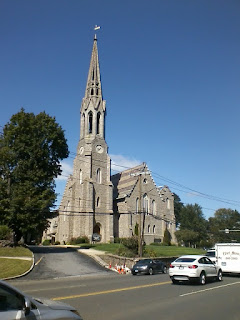The other day felt autumnal. It wasn't just the cool, crisp air or the fact that I was in Connecticut. I couldn't pinpoint exactly why I felt the fall had begun, or was well on its way, but I think I now know why.
Today the temperature reached 31C (88F), but the day still seemed autumnal. Granted, we didn't have the sauna-like humidity we had during an earlier heat wave. But there was something else. At first I thought it was just a feeling, but I realize now it was as visual as it was visceral.
Before going to work, I managed to ride by the Concrete Plant Park along the Bronx River. I could swear I saw the first tinges of yellow and orange in a few trees:
And, because there is less daylight every day than there was earlier in the summer, the sun isn't as intense, and the ground and buildings don't have as much time to absorb the heat. So, while the air temperature climbed over 30C, the heat didn't feel as oppressive as it did a few weeks ago.
There's one more signal of Fall, for me. My rides, whether to Connecticut or the college, seem easier now. That is one of the things I've always loved about cycling in September and October, at least in years when I've done a decent amount of riding: I can climb hills in a gear or two higher than I did in, say, April or even June. Also, on my ride the other day, I was pedaling into a 20-25 KPH wind most of the way to Connecticut and barely noticed it.
Since I have never farmed (and probably never will), the kind of cycling I've experienced this week is probably the closest I will come to a harvest: I am enjoying the fruits of all of the pedaling I've done over the past few months.
Today the temperature reached 31C (88F), but the day still seemed autumnal. Granted, we didn't have the sauna-like humidity we had during an earlier heat wave. But there was something else. At first I thought it was just a feeling, but I realize now it was as visual as it was visceral.
Before going to work, I managed to ride by the Concrete Plant Park along the Bronx River. I could swear I saw the first tinges of yellow and orange in a few trees:
And, because there is less daylight every day than there was earlier in the summer, the sun isn't as intense, and the ground and buildings don't have as much time to absorb the heat. So, while the air temperature climbed over 30C, the heat didn't feel as oppressive as it did a few weeks ago.
There's one more signal of Fall, for me. My rides, whether to Connecticut or the college, seem easier now. That is one of the things I've always loved about cycling in September and October, at least in years when I've done a decent amount of riding: I can climb hills in a gear or two higher than I did in, say, April or even June. Also, on my ride the other day, I was pedaling into a 20-25 KPH wind most of the way to Connecticut and barely noticed it.
Since I have never farmed (and probably never will), the kind of cycling I've experienced this week is probably the closest I will come to a harvest: I am enjoying the fruits of all of the pedaling I've done over the past few months.





